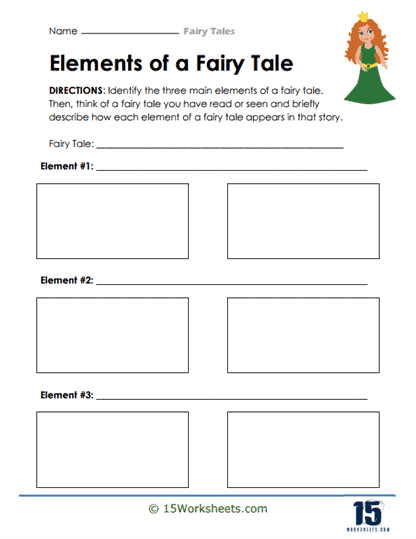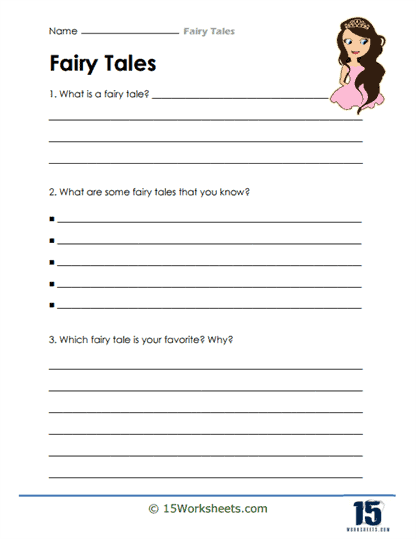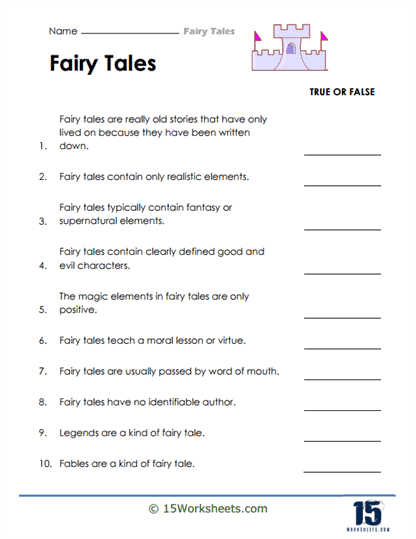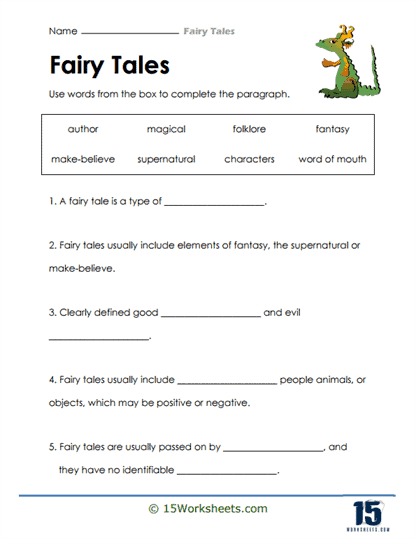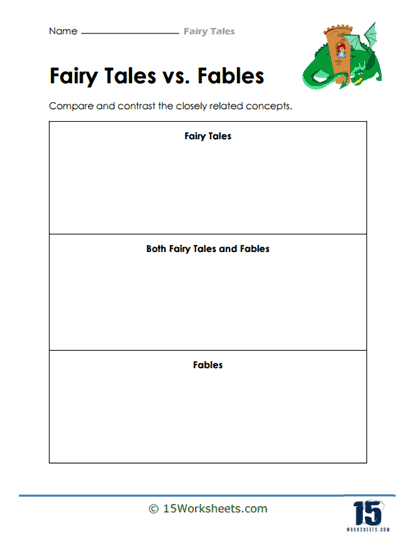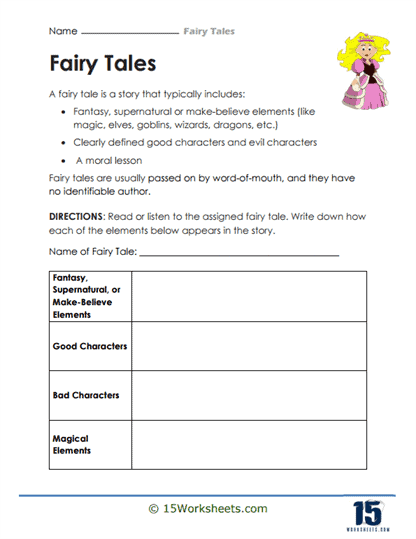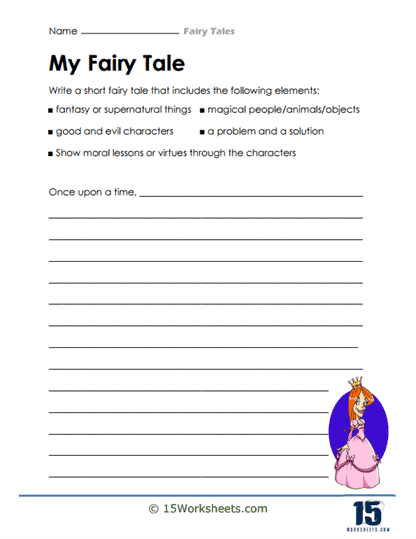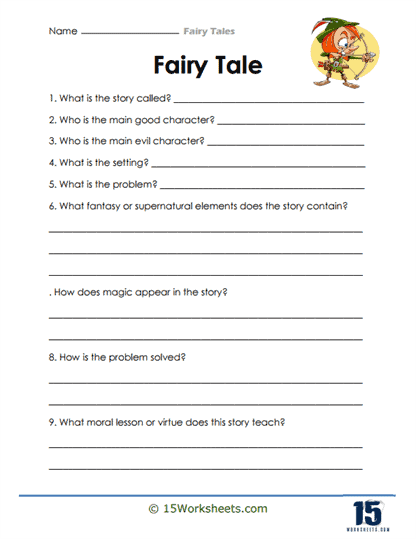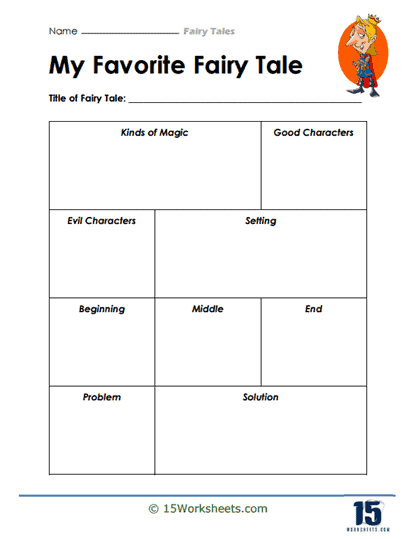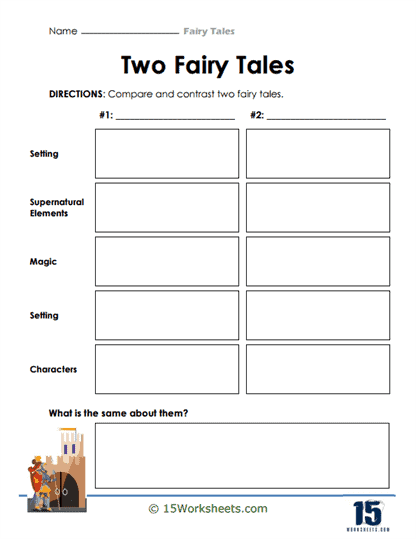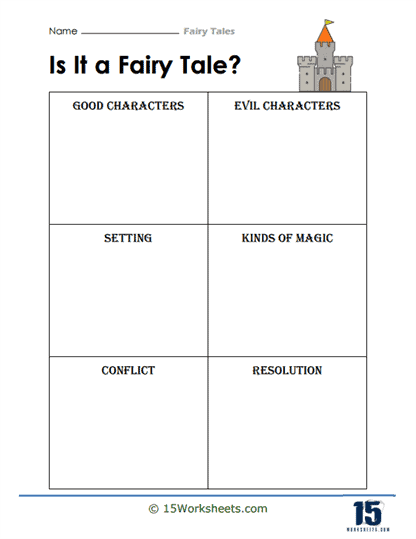Fairy Tales Worksheets
All About These 15 Worksheets
The collection of fairy tale worksheets provides a broad and structured approach to teaching students various aspects of fairy tales. Each worksheet focuses on building different literacy and comprehension skills, while engaging students with familiar story elements such as fantasy, good vs. evil characters, and magical themes.
Fairy tales aren’t just bedtime stories-they’re rich, magical blueprints for teaching kids how to think critically, write creatively, and maybe even side-eye an old crone offering apples. This whimsical worksheet collection invites students to explore the heart of fairy tales through everything from serious literary analysis to full-blown dragon doodles. Starting with the basics, “The Essential Elements,” “Identifying Manifestations,” “A Closer Look,” and “Taking Note of the Details” turn students into literary sleuths. They’re asked to sniff out the telltale signs of enchantment-recognizing spells, archetypes, and improbable plot twists like “Oh, she slept for how many years?” These exercises strengthen reading comprehension and make students realize that every fairy tale has a formula… and that evil stepmothers are weirdly consistent.
Once they’ve mastered the anatomy of a tale, it’s time for some high-level comparison with “Side-by-Side Comparison,” “Comparing Two Enchantments,” and the delightfully skeptical “Myth or Reality.” These worksheets encourage young readers to dig beneath the surface, contrasting stories like Cinderella and Snow White or evaluating which magical object is more effective: a glass slipper or a magic mirror? In “Myth or Reality,” kids must sort the fictional from the possible (talking animals = myth, jealousy = alarmingly real). It’s critical thinking meets fantasy land, where students are free to say, “I like the troll metaphor, but I find his bridge toll system problematic.”
Then comes the creative explosion. In “Writing A Magical Story,” “Be A Fairy Godparent,” and “Whimsical Gallery,” students don the author’s cape-or perhaps a glittery wizard robe-and build their own tales from scratch. They invent characters, brew conflicts, and resolve plots with originality and just enough sparkle. “Be A Fairy Godparent” even lets them rewrite or reimagine existing stories-what if the Big Bad Wolf needed therapy? Or Cinderella never left the ball because she started a DJ career? And “Whimsical Gallery” brings the visual flair, turning artistic expression into narrative insight as students draw enchanted forests, heroic beasts, or whatever strange thing lives at the bottom of that cursed well.
To deepen understanding and spark reflection, the collection includes “My Personal Favorite,” “Describe and Discuss,” and “The Good and The Evil.” These worksheets ask students to make judgments, defend opinions, and even argue on behalf of misunderstood villains. Who’s really the bad guy, and what makes a character “good” anyway? It’s a crash course in ethical storytelling, empathy, and persuasive communication-all wrapped in fairy tale fun. Expect strong stances like, “The witch was just enforcing forest zoning laws!” or “The Beast had communication issues, not a bad heart.”
And of course, no fairy tale exploration is complete without dissecting structure and morals. “Characters, Setting, Morals” lays out the storytelling trifecta, helping students break down each story into digestible parts. And just when they think they’re done, “Enchanted Word Box” swoops in with a lexicon of magical vocabulary. Students wield words like “benevolent” and “malevolent” with new confidence, perhaps even applying them at the dinner table (“This stew is a malevolent surprise, Mother”). Together, these fifteen worksheets build a bridge between the world of fantasy and real-world literacy skills. In the end, students aren’t just learning fairy tales-they’re learning to read more deeply, think more creatively, and tell their own stories with purpose and a pinch of pixie dust.
What Are Fairy Tales?
Fairy tales are much more than simple stories; they are timeless treasures that have captivated audiences for centuries. Defined by their magical and fantastical elements, these tales often feature characters such as fairies, witches, giants, and talking animals, all intertwined in a narrative that conveys important moral lessons. These enchanting tales use adventure and imagination to teach values like kindness, bravery, and caution, making them essential tools for passing down wisdom through generations. Whether we realize it or not, fairy tales offer us a deeper understanding of human nature, making them a vital part of storytelling traditions worldwide.
The origins of fairy tales stretch back to ancient oral traditions, long before they were written down. For centuries, elders passed these stories from one generation to the next, often as a form of education and entertainment around campfires or in small village gatherings. These oral traditions allowed fairy tales to evolve with each telling, adapting to the unique culture, values, and needs of each society. Despite the differences in settings or characters, the core themes of these stories—good versus evil, the triumph of the underdog, and the consequences of one’s actions—remained universally relatable, making fairy tales a global phenomenon.
Across different cultures, fairy tales have emerged in various forms, each reflecting the unique folklore of its people. In Africa, for instance, clever animals often play central roles, while in India, mystical beings and gods dominate the stories. However, the universal themes of love, courage, and deception remain constant, showing that despite geographical differences, human experiences and struggles are often the same. This shared understanding of life’s lessons is part of what gives fairy tales their enduring power and widespread appeal, transcending borders and uniting people through the shared language of storytelling.
The preservation of fairy tales owes much to collectors and writers like the Brothers Grimm, Charles Perrault, and Hans Christian Andersen. These literary figures traveled, recorded, and adapted these stories, ensuring their survival as printed works. The Brothers Grimm, for example, gathered German folktales and immortalized characters like “Snow White” and “Hansel and Gretel.” Charles Perrault refined and popularized French tales like “Cinderella” and “Sleeping Beauty.” Hans Christian Andersen, though, crafted his own original tales such as “The Little Mermaid” and “The Ugly Duckling,” adding emotional depth to traditional fairy tale themes. Their contributions ensured that fairy tales would not fade into obscurity, but continue to captivate generations.
Today, fairy tales remain relevant because they speak to universal human experiences. These tales offer hope, showing us that even in the face of adversity, good can prevail, and that love, kindness, and courage can overcome the darkest of obstacles. Their timeless messages continue to resonate, making fairy tales a powerful way to bridge the past with the present. In reading or telling a fairy tale, we connect with ancient traditions, finding wisdom and joy in stories that remind us that, no matter the circumstances, anything is possible.
Common Characteristics of Fairy Tales
Magical Elements – Fairy tales often contain supernatural or enchanted elements, such as spells, magical objects, or the ability to grant wishes.
Archetypal Characters – Many fairy tales feature stock characters, such as the evil stepmother, the helpless princess, the valiant hero, or the wise old man.
Problem-solving and Transformation – The protagonists in fairy tales often face challenges or conflicts that they must overcome, usually through cleverness, bravery, or the help of magical beings. Characters may undergo significant transformations, either literally (e.g., from a frog to a prince) or metaphorically (e.g., from a selfish person to a kind one).
Happy Endings – Fairy tales typically end with a resolution of the main conflict and a happy ending, often involving the hero’s reward (e.g., marrying a prince or princess) or the defeat of the villain.
Simple and Universal Themes – Fairy tales often deal with universal human experiences and themes, such as love, jealousy, courage, and the struggle between good and evil.
Fairy tales have continued to evolve and adapt over time, influencing literature, theater, film, and other forms of popular culture. They are a timeless form of storytelling that continues to capture the imagination of children and adults alike, offering both entertainment and valuable life lessons.
This collection of Fairy Tales worksheets invites students to embark on a magical journey into the world of fairy tales, where they will encounter dragons, princesses, talking animals, and moral dilemmas. Beyond enhancing their comprehension of these timeless stories, these worksheets empower students to think critically, appreciate diverse cultures, and explore the enduring wisdom of folklore.
As students engage with fairy tales from different corners of the world, they develop the capacity to analyze narratives, evaluate character choices, and appreciate the rich tapestry of human storytelling. These skills not only prepare them for academic success but also nurture their curiosity, empathy, and appreciation for cultural diversity.
Empower your students to embark on enchanting adventures with confidence, becoming not only well-read individuals but also more empathetic, culturally aware, and imaginative thinkers who carry the magic of fairy tales with them throughout their lives.
Unlock the doors to literary exploration and cultural understanding, one fairy tale at a time, and watch as your students become more engaged, enlightened, and enthusiastic learners.

